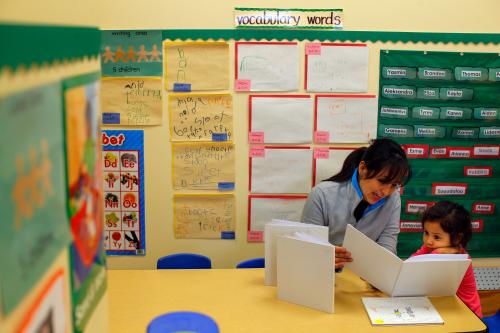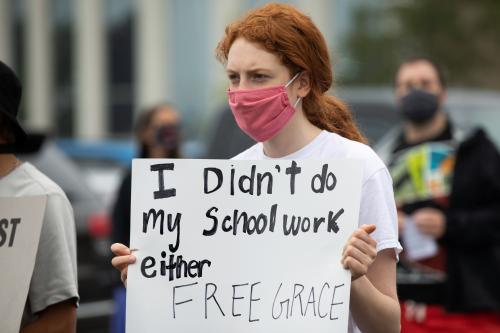Over the last several years, education policymakers and school leaders have worked to rein in excessively punitive school discipline practices. Motivated by concerns about disproportionality in discipline rates and the consequences of harsh discipline, they have limited the use of suspension and expulsion, especially for young children. It’s been among the most active areas of state and district education policymaking, while also attracting the attention of federal policymakers.
In this context, it seems remarkable that so many states continue to allow corporal punishment in schools and that there hasn’t been more legislative effort to end the practice. According to the Education Commission of the States, 23 states either explicitly allow corporal punishment in public schools or defer to localities on its use.
Perhaps even more remarkable is that state laws on corporal punishment, unlike many laws on exclusionary discipline, do not distinguish between children of different ages. We reviewed state legislation on corporal punishment (aided by research from the National Center for Safe Supportive Learning Environments). Our review turned up no cases of states prohibiting the use of corporal punishment for young children where the practice is allowed for older children. This is true even for children enrolled in school-based pre-K programs. State laws that allow educators to hit 14-year-olds generally allow educators to hit 4-year-olds as well.
We don’t accept that any child, of any age, should be subject to corporal punishment at the hands of a teacher or school administrator. However, with corporal punishment in grades K-12 still a contentious issue in some areas, we looked into the practice in pre-K in particular. While it appears less common at these ages—and harder to track, with many children in private child-care centers that do not provide data—we would hope that objections to corporal punishment for very young children are shared widely enough to motivate legislative action.
The landscape of corporal punishment of young children
Corporal punishment is the practice of intentionally inflicting pain upon a child in response to a behavior deemed unacceptable. It has a long history in U.S. schools, evoking images of paddles, belts, and open hands. Concerns about corporal punishment also have a long history, too, with New Jersey being the first state to ban the practice in 1867.
Today, corporal punishment laws vary across states, as well as across districts (and schools) within states. About half of all states ban it outright. Some say little about it, implicitly deferring to local leaders and educators, perhaps relying on child-abuse laws as guardrails. Others are more explicit.
For example, Oklahoma’s school discipline laws state that “nothing contained in this act shall prohibit any parent, teacher or other person from using ordinary force as a means of discipline, including but not limited to spanking, switching or paddling.” Its policy defines some limits—specifically for students with “the most significant cognitive disabilities”—but does not restrict its use for very young children. Even the restriction for students with severe disabilities is waived if the child’s parent or legal guardian provides written consent.
Figure 1, below, shows the legal landscape for the corporal punishment of preschool students. States colored in some shade of blue allow the practice. The different shades of blue reflect the number of preschool children (ages 3 to 5) who experienced corporal punishment during the 2015-16 school year according to the Civil Rights Data Collection (CRDC). These figures show the number of children who received corporal punishment, not the number of incidents, so a child who was punished multiple times would only count once. Moreover, these data reflect only children in public programs or receiving public services—and only the incidents that educators actually reported. While it’s hard to know the extent to which corporal punishment might be underreported, the U.S. Government Accountability Office identified evidence of underreporting in CRDC data of disciplinary incidents involving students with disabilities. That type of underreporting is possible here, too, though it cannot be known for sure.
The map shows clear trends by region, especially in the number of reports. Nearly all of the reported cases are in the South or parts of the Great Plains, generally in states with Republican state leadership. Ten states reported at least one preschooler receiving corporal punishment in 2015-16, for a total of about 1,500 children. Children in Texas and Oklahoma account for the majority of these cases. Mississippi and Oklahoma have the largest number of pre-K children subjected to corporal punishment relative to their public preschool populations reported in the CRDC data.
In all, the rates of corporal punishment are lower for pre-K than K-12. About 1 of every 1,000 preschool children in the CRDC data are reported to have been corporally punished in 2015-16, compared to about 2 of every 1,000 students in K-12 grades. Interestingly, pre-K corporal punishment patterns by race and ethnicity differ from the disproportionality observed in suspensions. Black and white children in public pre-K programs are both overrepresented among those receiving corporal punishment relative to their shares of the full public pre-K population. Latino children are substantially underrepresented: 11% of preschoolers receiving corporal punishment are Latino, compared to 29% of all children in public pre-K programs and 21% of children in public pre-K programs that reported at least one case of corporal punishment).
Some states allow corporal punishment, but they give parents an opportunity to opt out. For example, Texas law defers to districts on the use of corporal punishment, but it allows parents/guardians to opt out via a written, signed statement. However, decades of research in psychology and behavioral economics show that default options are powerful. Requiring families to actively opt out—and then do it again every new school year—likely leads to many families who oppose the practice unknowingly opting in. Moreover, schools don’t always comply with those parental requests, and it’s not at all clear that this question should be left to parents in the first place.
Evidence on the effects of corporal punishment
The strongest arguments against schools deliberately inflicting physical pain on preschoolers are rooted in ethics, not empirical research. In fact, issues of ethics and empirical evidence are interconnected, since it’s hard to imagine an institutional review board (IRB) approving the type of experimental study that would produce the clearest causal evidence of its effects.
Still, there is now an extensive body of research on this subject and, in fact, an extensive body of meta-analyses and reviews of this research. It comes with a couple of caveats. First, the evidence to date is more correlational than causal, with researchers attempting to control for differences between students who are and are not exposed to corporal punishment. Second, the evidence on the effects of pre-K children receiving corporal punishment at school is scarce. Most of the studies consider older children, and many consider the effects of corporal punishment at home as well as (or instead of) school.
Taken as a whole, this literature offers nothing to suggest corporal punishment as a promising strategy with long-term benefits. Proponents of corporal punishment tend to see it as way to secure compliance and prevent future negative behaviors (e.g., seeing the threat of being hit as a powerful deterrent). However, the positive effects–if and where they exist–tend to be very short term (e.g., getting a child to comply with an adult’s immediate command). They are overwhelmed by a broader set of negative outcomes, including in long-term compliance. Many studies find associations between corporal punishment and negative outcomes such as aggression and antisocial behavior, although the strength of these negative associations and the extent to which they represent causal effects continue to be debated.
Leading organizations such as the American Academy of Pediatrics and the American Psychological Association (APA) have condemned corporal punishment in schools, citing its likely harm to children. The APA recently passed a resolution that strongly condemns its use by parents as well.
Looking ahead
Ever since the U.S. Supreme Court ruled in 1977 that corporal punishment at school does not violate Eighth Amendment protections against “cruel and unusual punishment,” a push to curtail its use has come from the local and state levels. However, that work remains incomplete, with about 45% of U.S. schoolchildren living in states that still allow it.
Federal action seems unlikely, at least without a change in majority control of the Senate. House Democrats introduced a bill in 2019 that would prohibit states and local educational agencies that permit corporal punishment from receiving federal funding. However, that bill has not attracted Republican support and, with Congress not passing much legislation of late, looks unlikely to go anywhere anytime soon.
In the absence of federal action, state governments should take action on this issue, not leaving decisions about whether to harm young children to local leaders, educators, or even parents. Many issues in education are complicated, with reasonable arguments on multiple sides. This isn’t one of them. Even if the politics of student discipline do not allow for the full-fledged prohibition of corporal punishment, one would hope that enough support exists to stop the practice for preschool-age children.









Commentary
Ending corporal punishment of preschool-age children
October 13, 2020